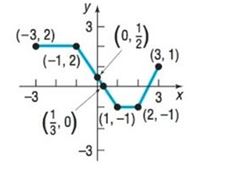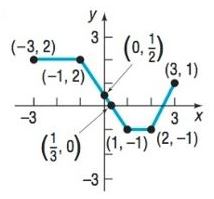
Concept explainers
In Problems 25-32, the graph of a function is given. Use the graph to find:
a. The intercepts, if any
b. The domain and range
c. The intervals on which the function is increasing, decreasing, or constant
d. Whether the function is even, odd, or neither
31.

To find: The following values using the given graph:
a. Intercepts( and intercepts)
b. The domain and range set of the function.
c. Increasing intervals, decreasing intervals and constant interval if any.
d. Nature of the function (even, odd or neither).
Answer to Problem 27AYU
From the graph, concluding the following results:
a. Intercepts( and intercepts)
.
b. The domain and range set of the function.
The domain of is or the interval .
The range of is or the interval .
c. The function is increasing in the interval , decreasing in the interval and it is constant in the intervals and in the given graph.
The given function is neither even nor odd.
Explanation of Solution
Given:
It is asked to find the intercepts ( and if any), domain and range, increasing intervals, decreasing intervals, and constant intervals of the function using the graph. Also, check whether the function is even, odd or neither.
Graph:

Interpretation:
a. Intercepts ( and intercepts): The points, if any, at which a graph crosses or touches the coordinate axes are called the intercepts.
The of a point at which the graph crosses or touches the is an , and the of a point at which the graph crosses or touches the is a
The intercepts of the graph are the points
and
The are and ; the is .
b. The domain and range set of the function.
To determine the domain of notice that the points on the graph of have between and , inclusive; and for each number between and , there is a point on the graph. The domain of is or the interval .
The points on the graph all have between to inclusive; and for each such number , there is at least one number in the domain. The range of is or the interval
c. Increasing intervals, decreasing intervals and constant interval if any.
It can be directly concluded from the graph that the curve is constant from to , then decreasing from to , then it is constant from to , then at last it is increasing from to .
Therefore, the function is increasing in the interval , decreasing in the interval and it is constant in the intervals and in the given graph.
d. Nature of the function (even, odd or neither).
By the theorem of test for symmetry, “A function is even if and only if its graph is symmetric with respect to the . A function is odd if and only if its graph is symmetric with respect to the origin”.
It can be easily concluded from the graph that it is neither symmetric with respect to nor symmetric with respect to .
Therefore, the given function is neither even nor odd.
Chapter 2 Solutions
Precalculus Enhanced with Graphing Utilities
Additional Math Textbook Solutions
Thinking Mathematically (6th Edition)
Elementary Statistics: Picturing the World (7th Edition)
A First Course in Probability (10th Edition)
College Algebra with Modeling & Visualization (5th Edition)
Introductory Statistics
Algebra and Trigonometry (6th Edition)
- I need help making sure that I explain this part accutartly.arrow_forwardPlease help me with this question as I want to know how can I perform the partial fraction decompostion on this alebgric equation to find the time-domain of y(t)arrow_forwardPlease help me with this question as I want to know how can I perform the partial fraction on this alebgric equation to find the time-domain of y(t)arrow_forward
- Evaluate F³ - dr where ♬ = (4z, -4y, x), and C' is given by (t) = (sin(t), t, cos(t)), 0≤t≤ñ .arrow_forwardMid-Term Review Find the formula for (f + g)(x). f(x) = x² - 10x + 25 and g(x) = x² - 10x + 24 (f + g) (x) = [ 2 ]x² X + DELL Skip Sarrow_forwardCalculus III May I please have some elaborations on Example 2 part a? Thank you.arrow_forward
- 1. A bicyclist is riding their bike along the Chicago Lakefront Trail. The velocity (in feet per second) of the bicyclist is recorded below. Use (a) Simpson's Rule, and (b) the Trapezoidal Rule to estimate the total distance the bicyclist traveled during the 8-second period. t 0 2 4 6 8 V 10 15 12 10 16 2. Find the midpoint rule approximation for (a) n = 4 +5 x²dx using n subintervals. 1° 2 (b) n = 8 36 32 28 36 32 28 24 24 20 20 16 16 12 8- 4 1 2 3 4 5 6 12 8 4 1 2 3 4 5 6arrow_forward= 5 37 A 4 8 0.5 06 9arrow_forwardConsider the following system of equations, Ax=b : x+2y+3z - w = 2 2x4z2w = 3 -x+6y+17z7w = 0 -9x-2y+13z7w = -14 a. Find the solution to the system. Write it as a parametric equation. You can use a computer to do the row reduction. b. What is a geometric description of the solution? Explain how you know. c. Write the solution in vector form? d. What is the solution to the homogeneous system, Ax=0?arrow_forward
- 2. Find a matrix A with the following qualities a. A is 3 x 3. b. The matrix A is not lower triangular and is not upper triangular. c. At least one value in each row is not a 1, 2,-1, -2, or 0 d. A is invertible.arrow_forwardFind the exact area inside r=2sin(2\theta ) and outside r=\sqrt(3)arrow_forwardA 20 foot ladder rests on level ground; its head (top) is against a vertical wall. The bottom of the ladder begins by being 12 feet from the wall but begins moving away at the rate of 0.1 feet per second. At what rate is the top of the ladder slipping down the wall? You may use a calculator.arrow_forward
 Calculus: Early TranscendentalsCalculusISBN:9781285741550Author:James StewartPublisher:Cengage Learning
Calculus: Early TranscendentalsCalculusISBN:9781285741550Author:James StewartPublisher:Cengage Learning Thomas' Calculus (14th Edition)CalculusISBN:9780134438986Author:Joel R. Hass, Christopher E. Heil, Maurice D. WeirPublisher:PEARSON
Thomas' Calculus (14th Edition)CalculusISBN:9780134438986Author:Joel R. Hass, Christopher E. Heil, Maurice D. WeirPublisher:PEARSON Calculus: Early Transcendentals (3rd Edition)CalculusISBN:9780134763644Author:William L. Briggs, Lyle Cochran, Bernard Gillett, Eric SchulzPublisher:PEARSON
Calculus: Early Transcendentals (3rd Edition)CalculusISBN:9780134763644Author:William L. Briggs, Lyle Cochran, Bernard Gillett, Eric SchulzPublisher:PEARSON Calculus: Early TranscendentalsCalculusISBN:9781319050740Author:Jon Rogawski, Colin Adams, Robert FranzosaPublisher:W. H. Freeman
Calculus: Early TranscendentalsCalculusISBN:9781319050740Author:Jon Rogawski, Colin Adams, Robert FranzosaPublisher:W. H. Freeman
 Calculus: Early Transcendental FunctionsCalculusISBN:9781337552516Author:Ron Larson, Bruce H. EdwardsPublisher:Cengage Learning
Calculus: Early Transcendental FunctionsCalculusISBN:9781337552516Author:Ron Larson, Bruce H. EdwardsPublisher:Cengage Learning





